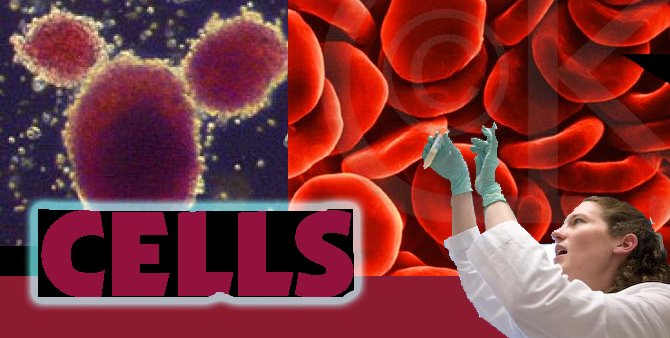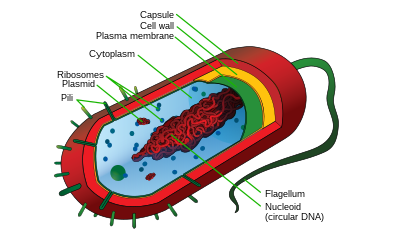Each cell is at least somewhat self-contained and self-maintaining: it can take in nutrients, convert these nutrients into energy, carry out specialized functions, and reproduce as necessary. Each cell stores its own set of instructions for carrying out each of these activities.
Prokaryotic cells
The prokaryote cell is simpler than a eukaryote cell, lacking a nucleus and most of the other organelles of eukaryotes. There are two kinds of prokaryotes: bacteria and these share a similar overall structure.
A prokaryotic cell has three architectural regions:
- on the outside, flagella and pili project from the cell's surface. These are structures (not present in all prokaryotes) made of proteins that facilitate movement and communication between cells;
- enclosing the cell is the cell envelope - generally consisting of a cell wall covering a plasma membrane though some bacteria also have a further covering layer called a capsule. The envelope gives rigidity to the cell and separates the interior of the cell from its environment, serving as a protective filter. Though most prokaryotes have a cell wall, there are exceptions such as Mycoplasma (bacteria) and Thermoplasma (archaea)). The cell wall consists of peptidoglycan in bacteria, and acts as an additional barrier against exterior forces. It also prevents the cell from expanding and finally bursting (cytolysis) from osmotic pressure against a hypotonic environment. Some eukaryote cells (in plants and fungi) also have a cell wall;
- inside the cell is the cytoplasmic region that contains the cell genome (DNA) and ribosomes and various sorts of inclusions. A prokaryotic chromosome is usually a circular molecule (an exception is that of the bacterium Borrelia burgdorferi, which causes Lyme disease). Though not forming a nucleus, the DNA is condensed in a nucleoid. Prokaryotes can carry extrachromosomal DNA elements called plasmids, which are usually circular. Plasmids enable additional functions, such as antibiotic resistance.

Diagram of a typical animal (eukaryotic) cell, showing subcellular components.
Organelles:
(1) nucleolus
(2) nucleus
(3) ribosome
(4) vesicle
(5) rough endoplasmic reticulum (ER)
(6) Golgi apparatus
(7) Cytoskeleton
(8) smooth endoplasmic reticulum
(9) mitochondria
(10) vacuole
(11) cytoplasm
(12) lysosome
(13) centrioles within centrosome
COMPARISON BEETWEEN PROKARYOTES AND EUKARYOTES CELLS
Organelles:
(1) nucleolus
(2) nucleus
(3) ribosome
(4) vesicle
(5) rough endoplasmic reticulum (ER)
(6) Golgi apparatus
(7) Cytoskeleton
(8) smooth endoplasmic reticulum
(9) mitochondria
(10) vacuole
(11) cytoplasm
(12) lysosome
(13) centrioles within centrosome
COMPARISON BEETWEEN PROKARYOTES AND EUKARYOTES CELLS
| Prokaryotes | Eukaryotes | |
|---|---|---|
| Typical organisms | bacteria, archaea | protists, fungi, plants, animals |
| Typical size | ~ 1-10 µm | ~ 10-100 µm (sperm cells, apart from the tail, are smaller) |
| Type of nucleus | nucleoid region; no real nucleus | real nucleus with double membrane |
| DNA | circular (usually) | linear molecules (chromosomes) with histone proteins |
| RNA-/protein-synthesis | coupled in cytoplasm | RNA-synthesis inside the nucleus protein synthesis in cytoplasm |
| Ribosomes | 50S+30S | 60S+40S |
| Cytoplasmatic structure | very few structures | highly structured by endomembranes and a cytoskeleton |
| Cell movement | flagella made of flagellin | flagella and cilia containing microtubules; lamellipodia and filopodia containing actin |
| Mitochondria | none | one to several thousand (though some lack mitochondria) |
| Chloroplasts | none | in algae and plants |
| Organization | usually single cells | single cells, colonies, higher multicellular organisms with specialized cells |
| Cell division | Binary fission (simple division) | Mitosis (fission or budding) Meiosis |
| Typical animal cell | Typical plant cell | |
|---|---|---|
| Organelles |
|
|




No comments:
Post a Comment